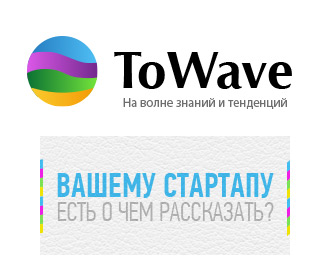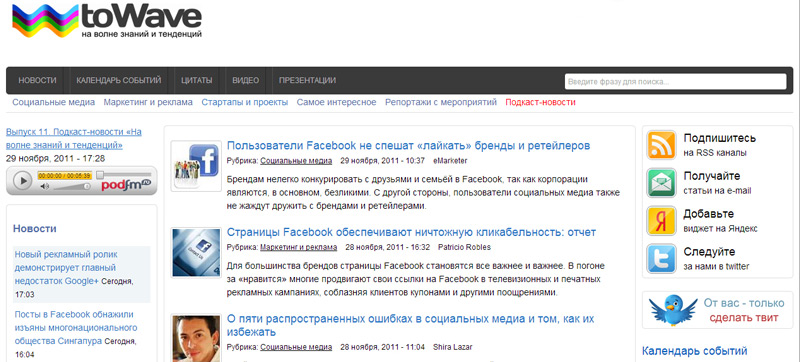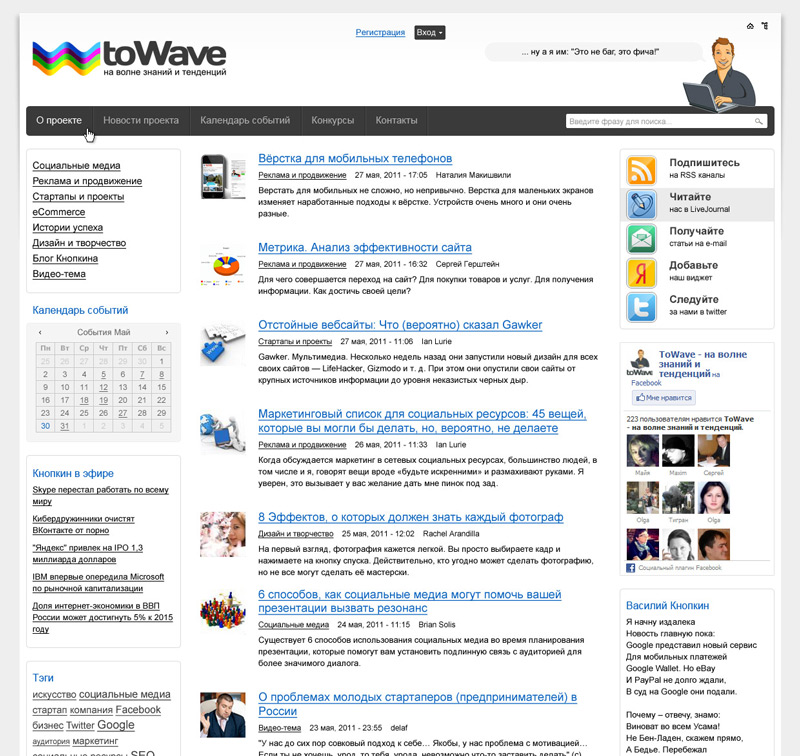How I started a project about startups, and how it developed in practice
 A couple of years ago there was a real boom in content sites, where there is something interesting on one particular topic. Something has grown, something is not - for example, hundreds of websites for photographers have definitely bent, Habr has grown very well - and at that time I developed and sold two projects profitably.
A couple of years ago there was a real boom in content sites, where there is something interesting on one particular topic. Something has grown, something is not - for example, hundreds of websites for photographers have definitely bent, Habr has grown very well - and at that time I developed and sold two projects profitably.The third one wanted to do in view of the experience gained - and I started from scratch again.
Today I am ready to tell what was done and how - and I want to ask you for feedback on the project.
')
How it all began
The first project was about trading on the stock exchange: then it was a very popular topic, but, alas, the site quickly shifted to the topic of Forex. Understanding deeper and deeper, I realized that with our brokers it all resembles a game with a casino. Therefore, I found a company in England, which was regulated and audited by British supervisory companies, and became their partner in the Russian Federation, and after six months of work I sold the project for personal reasons.
The second purely content site was a travel portal that developed well and quickly. Here I got an excellent experience in teamwork and I recruited people who worked pretty well together. The site has been developing for almost two years, until at some point I did not understand that it was impossible to conduct two projects at the same time. Purely psychologically difficult to see that there is something that does not develop. Then I sold it and invested the money in a new project.
Then it went easy. It is no secret that many western trends recur over time with us. In most cases, what is now in trend in America will be a trend with us in about a year or two. I was just wondering how projects are developing, how and what is being spun in the West in order to understand what could be on the market. I decided to collect as much information from Internet marketing bison, owners of start-ups and other people who had shot — and launched a website where all this could be put. This is how the online edition of ToWave appeared.
The first steps
Let me remind you, a year ago everybody felt like he was doing a social network with his own special atmosphere. I did not want to repeat this experience, so the concept was chosen simple: to make such a resource that is really interesting and useful to read . Hence - a clear line about the project work, an emphasis on facts and other features. At the start there was a team from the previous project (now many people work from there in ToWave), experience in developing content sites and a certain amount of personal money.
At first, I just wanted to make a website where translations of articles from Western sources would be published . I chose those people who write practically useful things and started sending requests for translation of articles. That is, I translate - and just ask permission to publish such material.
Smashingmagazine represented by Vitaly Friedman proposed a license agreement: it was postponed until better times. Mashable, in the face of Tamar Weinberg, generally refused categorically. In general, it seems to be predictable: it was necessary to collect at least a dozen failures in order to retreat, so after a little grief, I went further along the list of sites.
And then we went to the agreement . Damn nice to get an answer from an authoritative person: not a template, not a formal reply, but a lively human response, which the comrade, about whom you had just read, wrote himself - and that was just a few minutes ago. Such consent was given by such authors as Chris Brogan, Seth Godin, Brian Solis and others. Consent came from Businessinsider, Seomoz, Conversationmarketing, Smallbiztrends, Noupe, Emarketer and a lot of others. Every time a new letter from such sites fell into inbox, I opened it with passion and fear: if there is no there is a sentence, a cross on transfers of a mass of interesting and useful things. And if consent is a great incentive to develop.
As a result, it turned out to cooperate with approximately 40% of the authors and sites from the original list. I think if by this time I already had a large project, the percentage would be higher. At the same time, many good resources sent refusals or requests for amounts in the amount of $ 400-500 for one translation of their material. I do not know who pays them such money, but it seems that for many it is the norm.
For translations, it was selected that it would not become outdated very quickly (for a year or two at least), really interesting cases or practical tips that can be effectively applied in our conditions. After a couple of days, we had the first translations that I showed to my friends on social networks — and the first visitors, because word of mouth began to carry information about an interesting resource.
Development
People went to the site, read the article and left. In theory, with the development of the project and an increase in the number of materials, the flow of people would constantly increase: such content-oriented resources as Habr, Autokadabra, D3 and many others proved this. But it was necessary to accelerate - a channel was needed that would allow not only reading, but also subscribing. The site was almost "out of the box" was an RSS feed, which became popular - and it was decided to think about other ways to save readers.
The obvious way out seemed to be the mailing list or with a digest for the week (as does E-xecutive and other sites) or with “gold” materials directly to the mail. Even then, the stream of translations was quite large, so in the second version the reader would receive too many letters: base segmentation and other difficulties would be necessary. As a result, it seemed to me that, as such, the mailing list is far from what the project needs in the 21st century, when there are social networks.
We launched a group on Facebook and started to actively tweet . These two channels have been developing since May - and they give quite a lot of traffic when new good materials are released. Twitter is also very cool spread: many use it as a bookmark for a useful link and at the same time show a link to friends. I didn’t want to go on Vkontakte for a long time - after all, obviously not our audience - but about a month ago they started to work there, but not very actively.
News and Interviews
A very important point was the transition to the news . At first, neither I nor the team wanted this - we even wrote on the main page that we did not publish the news like everyone else. The fact is that then the content site always took exactly the news and was unthinkable without them. In the end, after much deliberation, we decided to try - and realized that this benefits the project. For example, 4 news items are approximately equal in terms of reaching one serious article in the audience - and much less in terms of complexity. News expanded the audience because new people came to them, often from search. The news was good.
Each news took a rather simple way: someone heard about something interesting or found something useful in subscriptions (and everyone in the team is actively developing and therefore subscribed to a bunch of foreign resources on their topic) - then factchipping was made and the news went to publication. When domestic news began to appear, fact-tracking became a very important thing - it was very easy to miss a rumor, a duck, or just something that the journalist wrote without really understanding. There was a mechanic, in fact, own writing news about the event. A month later, we no longer waited for someone's informational messages, but wrote ourselves.
It began, probably with the fact that there was sensational news with Tinkov Bank and Odnoklassniki, when the bank’s collectors came to the debtor directly to the social network and began to make noise there. Then we found this person, interviewed on Twitter, received comments from Tinkov (the owner of the bank), Anisimov (responsible for the marketing of the bank) - and collected interesting material. Two waves collapsed: those who resented the actions of the collectors - and those who began to resent that the debtor was from MMM. Holivar was born (in the course of it, by the way, my karma here has suffered greatly from both sides). For some reason, I was recorded as a supporter of the debtor, although I explained that I did not like the method of “knocking out” debts through social networks. The initial news literally scattered everywhere, and the site almost went away from habraeffekt and links to various news resources. Since then, we are always looking for "tasty" news ourselves.
Today, writing one news takes 30-90 minutes from the appearance of facts . It looks like this: for example, yesterday on Facebook a friend of mine slipped through that the project “Startup Poster” raised investments. Like the 3 million real green dollars of our intended adversary. I immediately signed with Alena Popova (project manager) and found out that yes, her project received investments. Then he took comments from Alena and in 40 minutes the news was already on ToWave.
Another good format turned out to be an interview . At first, Western specialists were selected, who had something to say, and then realized that there are a lot of people around us, right here in Russia and in the CIS, who can learn a lot. Now the topic of the interview is also on stream. Of the most interesting in the IT-topic was, for example, an interview with Evernote.
In parallel, they launched other formats, for example, a calendar of events. True, it has not yet reached its full capacity: now 90% of the events relate to Moscow. Recently launched a video: there are a decent amount of interesting videos from experts on different video hosting sites. We publish far from all, but only those that we think will be exactly useful for visitors, that is, where useful information is still more important than such a “slow” format in terms of time loss.
Design
The first design option:

A little bit later:

And even later:

About the team and money
At first I was responsible for all activities, and Irina was responsible for publishing the content. Then there was more work, and another man appeared. Work again became more - one more. Irina became an editor, and the team eventually grew to 8 people today. Of the "non-core" programmer and designer, and the rest work either with translations or with news interviews and other content. The project is coordinated directly by me and Irina, but even if we suddenly fall off from the team on a trip, get sick at the same time, or do not get in touch, everyone will work - in this respect we are quite autonomous. We specifically selected people who would care about his fate in a team.
In the office, only two people, the rest work remotely. It helps that there was the experience of two projects, where everything was done that way: it is very, very convenient. There is no strong difference between time zones, so everything is online in approximately the same interval, which helps to resolve any issues very quickly. Our main channels of communication are ICQ for urgent, mail for more tolerant and Dropbox for files. No special systems such as trackers are deployed.
As for payment, the whole project is on me (at first I used the funds from the sale of the car, then I added more money from the travel portal), and so far no profit is generated. I don’t want to sell such a project: there were already offers from investors, but from non-core ones. For me, it is important that ToWave become really big and work fine: you can “break money” on another. The main thing is that now it is still possible to maintain the project line, the way it should be in our eyes. Although we have much to strive for and we have many plans.
Technical details
The site was originally made on WordPress. Then this engine seemed to me the most successful for a small thematic social network. We painted the design, collected the functionality, but something was wrong. As a result, after 2 weeks, we switched to Drupal.
Pager is made on the "motives" of this topic . The likes module is integrated with votingapi: allows you to add a set of widgets for voting in social networks. The set of widgets is flexibly configured, the order of icons changes. such a vote can be enabled for any type of content.
Self-written modules (all available on Github):
- Point break - blog rating.
- Sharemylife - creates a set of widgets for integration with social networks, likes with counters. Very flexible configuration: set the display location, weight, the ability to output manually in the template, and of course the order of the widgets, which is done with drag-n-drop.
- Ynews - exporting materials in the RSS format to Yandex.News (by the way, gave a lot in terms of development).
- Character - output random phrases.
- Likes - voting module through social networks.
On all ToWave, there is not a single hack of the module, especially the Drupal core. Total installed and running - a total of 56 modules.
I ask for feedback
The project ToWave.ru was born on January 25, 2011 (although there were earlier translations) and has been successfully operating for a year and a half. It’s time for us to move on: we have already redesigned the main page three times, completely redesigned and did many other things. Now we need to become better and better in order to become first in the field. There have already been consultations with media managers and Internet marketers, and each one told absolutely different things. Now I ask for your help: how is it convenient for you to receive information about start-ups, project management and other useful things? What is missing on the site? What would you like to see there? Please tell me what you think.
In order not to come to you empty-handed, look in our corporate blog on Habré, there is a contest where the most useful feature requests change for prizes (there are 5 tablets and books).
Source: https://habr.com/ru/post/154945/
All Articles